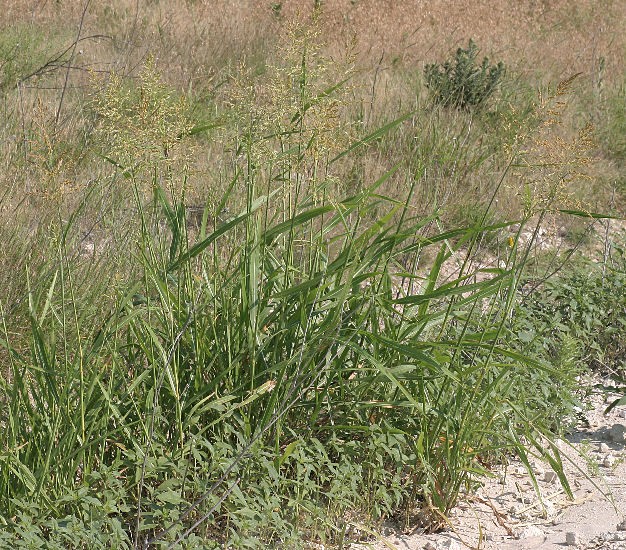Sorghum halepense
Johnsongrass
Synonyms: Holcus halepensis, Sorghum miliaceum, Andropogon halepensis
Class: Liliopsida
Order: Cyperales
Family: Poaceae

Source: http://www.opsu.edu/Academics/SciMathNurs/NaturalScience/
Description
Johnsongrass, Sorghum halepense, is a fast-growing perennial that can grow up to 7 feet tall. This grass is able to spread easily by a system of rhizomes which are horizontal underground roots. Leaf blades are about 1 inch wide and can grow up to 2ft long. The numerous seeds that develop in the fall are yellow to purplish, occurring in a large, spreading, open seed head.
Ecological Threat: Johnsongrass is very invasive and can reduce corn and soybean yields over 30% and 40% respectively, even with normal control efforts. It is able to easily out-compete native grasses and can be found along roadsides all over Texas. Thick stands of Sorghum halepense can create a monoculture and alter the diversity of an area and effect the ecosystem and animals dependent on diverse grass cultures. Healthy plants can provide good forage for livestock. However, foliage of Johnsongrass can produce toxic amounts of cyanide if growing under stressful conditions, such as cold (i.e. frost), extreme heat or drought or physical stresses and may be poisonous to livestock when ingested. High nitrate levels in the plant can complicate the problem and produce nitrate poisoning in sheep and cattle. All of these factors make Sorghum halepense one of the 10 most noxious weeds in the world.
Biology: Johnson grass flowers from May to October and reproduces by seeds, which stay viable for up to 20 years. Rhizomes also help it to reproduce quickly and one plant can spread across areas up to 200 feet. New stands readily establish from small pieces of rhizome. This grass can also be spread by seeds carried in contaminated hay and farming equipment.
History: Introduced to South Carolina from Turkey in the early 1800s as a foraging crop. It was named after Colonel William Johnson, who introduced this species to his fertile river bottom farm in Alabama around 1840. This grass spread so quickly that it was the species target of the first federal grant specifically for weed control in 1900.
U.S. Habitat: Johnsongrass grows well in disturbed soils, along irrigation ditches or stream bottoms; and along roadsides or cracks between sidewalks
Distribution
Native Origin: Mediterranean region of Europe and Asia and Asia Minor
U.S. Present: All except AK and MN
Resembles/Alternatives
Easily confused for the native grass Purpletop (Tridens flavus). However, purpletop has four to seven florets per spikelet, whereas Johnsongrass appears to have a single floret when viewed with the naked eye. When Johnsongrass is newly forming it can look like corn seedlings. To tell the difference, look at the rhizomes, which are white to pinkish on new forming plants.
Management
Preventing johnsongrass from becoming established in new areas is the best available control method, because the weed spreads in multiple ways. In the summer, johnsongrass can be controlled by repeated tilling every few weeks. Rhizomes of the plant can also freeze out during the winter, which helps control infestations in agricultural fields. Grazing animals, such as goats and hogs, can also help in johnsongrass control as long as the grasses is not stressed by environmental or physical factors.
The critical time to kill johnsongrass is while the weed is becoming established and before it has spread over the entire field. For sites with established infestations, a fall application of Roundup or Touchdown will kill emerged tissue and often developing rhizomes. If grazed or mowed closely for at least two years, the plants become weak and stunted and the rhizomes become concentrated near the soil surface.
Unfortunately, some variations of Sorghum halepense have become resistant to Roundup (glyphosate) and have been observed globally to be resistant to group B/2 herbicides (ALS inhibitors). Studies are continuing for the management of johnsongrass with a mixture of different herbicides and tilling strategies.
References
Woodward, Susan L., and Joyce Ann. Quinn. 2011. Johnsongrass. Encyclopedia of Invasive Species: From Africanized Honey Bees to Zebra Mussels. Santa Barbara, CA: Greenwood. 469-72. Print.
Internet Sources
http://www.fs.fed.us/database/feis/plants/graminoid/sorhal/all.html#INTRODUCTORY
http://www.oardc.ohio-state.edu/weedguide/singlerecord.asp?id=80
http://extension.missouri.edu/p/IPM1007-69
http://www.weedscience.org/Details/Case.aspx?ResistID=5091
http://www.naturalbiodiversity.org/biobullies/downloads/Johnson%20Grass.pdf
http://www.invasiveplantatlas.org/subject.html?sub=3075
 Texas Invasive Species Institute
Texas Invasive Species Institute